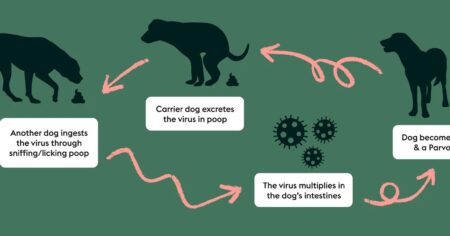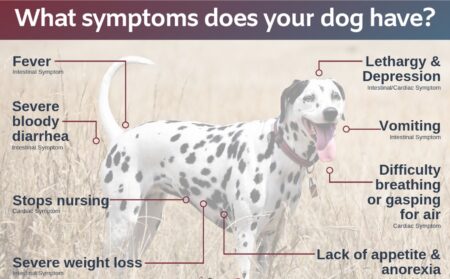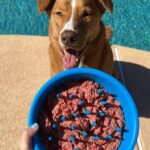
How Do Dogs Get Parvo? Causes, Symptoms, and Treatment
Parvo is a highly contagious viral infection that affects dogs, particularly puppies. This virus can be deadly and is often transmitted through contaminated feces or objects that have come into contact with infected feces.
In this article, let’s explore how dogs get parvo, the symptoms to look out for, and how it can be treated. Protecting your furry friend from this potentially devastating illness starts with understanding the risks and taking the necessary precautions to keep them healthy and safe.
SEE ALSO: Is Your Dog Dragging Butt? Here is Why!
How Do Dogs Get Parvo?
According to the American Veterinary Medical Association, dogs typically contract parvovirus, or parvo, through contact with infected dogs, feces, or contaminated objects or surfaces like kennels, food and water bowls, collars and leashes, and the hands and clothing of people who handle infected dogs.
What Is Canine Parvovirus Infection in Dogs?
Canine parvovirus infection, or simply “parvo,” is a highly contagious viral infection that attacks a dog’s intestines and immune system and the virus can cause severe vomiting, diarrhea, and dehydration, often leading to death if left untreated.
Canine parvovirus is a member of the parvoviridae family, which includes other viruses like feline panleukopenia and the human parvovirus B19 and the virus is highly resistant to environmental conditions and can survive on surfaces, objects, and soil for long periods.
Can Adult Dogs Get Parvo?
Yes, although adult dogs are less likely to contract parvo than puppies, it is still possible for adult dogs to become infected with the virus. Adult dogs can become exposed to the virus in the same ways that puppies do, such as through contact with contaminated feces or objects.
However, adult dogs are generally better equipped to fight off the virus because they have had more time to build up immunity through previous vaccinations or exposure to the virus. In addition, adult dogs typically have a more mature immune system that is better able to mount a defense against the virus.
Can Humans Get Parvo from Dogs?
Humans cannot directly contract parvovirus from dogs. Parvovirus is a species-specific virus, which means that it can only infect dogs and certain other species, such as cats and raccoons. The human version of parvovirus, parvovirus B19, is a different virus that causes a different disease, known as the fifth disease or slapped cheek syndrome, which is characterized by a distinctive rash.
However, humans can indirectly spread the virus to other dogs by carrying contaminated objects or surfaces on their hands or clothing.
Are There Different Types of Canine Parvovirus Infections?
Yes, there are several strains of canine parvovirus (CPV) that can cause infections in dogs, each with its own set of characteristics and symptoms. The two most common types of canine parvovirus infections are Canine minute virus (CPV1) and CPV2.
CPV-2: This is the second strain of the virus, which was first identified in the late 1970s. It caused widespread outbreaks in dogs, particularly puppies, and is still prevalent today. CPV-2a and CPV-2b are the two strains of the virus that evolved and have become more common in recent years.
What Causes Parvo in Dogs?
Several factors can contribute to the development of parvo in dogs, including:
- Exposure to contaminated environments: As mentioned earlier, dogs can become infected with parvo through contact with contaminated feces or objects. This is the primary cause of parvo in dogs and is why it is important to keep your dog away from areas where parvo is known to be present.
- Lack of vaccination: Puppies are especially susceptible to parvo because they have not yet built up immunity to the virus through vaccinations.
- Weakened immune system: Dogs with weakened immune systems, such as those suffering from illness or receiving chemotherapy, are more susceptible to parvo.
- Inadequate hygiene: Dogs that are not kept clean and healthy are more likely to develop parvo. This includes dogs that are not regularly bathed or groomed or dogs that live in unsanitary conditions.
- Genetic susceptibility: Certain breeds of dogs, such as Rottweilers and Doberman Pinschers, are more genetically susceptible to parvo than other breeds.
What Are the Symptoms of Parvo in Dogs?
The symptoms of parvo can vary depending on the strain of the virus and the individual dog, but some common symptoms include:
- Vomiting and diarrhea: These are the most common symptoms of parvo and can lead to severe dehydration. The diarrhea may be bloody and foul-smelling.
- Lethargy and depression: Dogs with parvo may become lethargic and appear depressed or uninterested in their surroundings.
- Anorexia: Dogs with parvo may stop eating and drinking, leading to weight loss and dehydration.
- Fever: Some dogs with parvo may develop a fever, which can lead to dehydration and weakness.
- Abdominal pain: Dogs with parvo may experience abdominal pain and discomfort, particularly in the area of the intestines.
- White gums: In severe cases of parvo, a dog’s gums may become pale or white due to anemia.
- Bloody stool: Dogs with parvo may pass bloody stools, which is a sign of intestinal damage caused by the virus.
- Shock: In severe cases of parvo, a dog may go into shock due to dehydration, electrolyte imbalance, and organ failure. This can be life-threatening and requires immediate veterinary attention.
- Death: Parvo can be fatal, particularly in puppies and young dogs, if not treated promptly and effectively. The mortality rate for dogs with parvo can be as high as 91% if left untreated.
Early Signs of Parvo
The early signs of parvo can be subtle and may not be immediately noticeable, especially in young puppies. Some common early signs of parvo include:
- Lethargy: Puppies with parvo may become more tired and less active than usual. They may sleep more and have less energy for play and other activities.
- Anorexia: Puppies with parvo may stop eating and drinking, even if they are normally enthusiastic about food.
- Vomiting: This is a common symptom of parvo in dogs, particularly puppies. When a puppy vomits, it is often because the virus has caused inflammation and damage to the intestinal lining. The vomiting associated with parvo is usually projectile, meaning that the puppy will vomit rather than simply regurgitate food.
- Decreased appetite: Puppies with parvo may lose their appetite and begin to eat less or refuse food entirely.
- Weight loss: As a result of decreased appetite and vomiting, puppies with parvo may lose weight quickly.
- Abnormal stool: Puppies with parvo may have stool that is softer, runnier, or of a different color than normal. The stool may also contain blood.
- Fever: Puppies with parvo may have a fever that causes them to become lethargic and uncomfortable.
Near-Death Signs of Parvo
When parvo progresses to a more advanced stage, it can cause serious and potentially life-threatening symptoms. Some of the near-death signs of parvo include:
- Severe dehydration: This is one of the most serious complications of parvo and can lead to shock, organ failure, and death if not treated promptly.
- Hemorrhagic gastroenteritis: This is a condition that causes severe bleeding from the intestines, leading to a bloody stool and severe dehydration.
- Multiple organ failure: If parvo is left untreated, it can lead to multiple organ failure, particularly of the kidneys and liver.
- Shock: Shock is a life-threatening condition that occurs when the body is unable to maintain adequate circulation and perfusion of vital organs.
- Coma: In severe cases of parvo, a puppy may become comatose and unresponsive. This is a sign of advanced disease and requires immediate veterinary attention.
Symptoms of Parvo in Older Dogs
Older dogs that have been exposed to parvo may exhibit different symptoms than younger dogs. Some common symptoms of parvo in older dogs include:
- Depression and lethargy: Older dogs with parvo may become very tired and depressed, with little interest in food, play, or other activities.
- Weight loss: Older dogs with parvo may lose weight quickly due to decreased appetite and vomiting.
- Vomiting and diarrhea: Older dogs with parvo may vomit and have diarrhea, although the stools may not be as bloody as in younger dogs.
- Fever: Older dogs with parvo may develop a fever, which can cause them to become uncomfortable and lethargic.
- Abdominal pain: Older dogs with parvo may experience abdominal pain and discomfort due to inflammation of the intestinal lining.
- Dehydration: Older dogs with parvo may become dehydrated due to vomiting and diarrhea, leading to weakness and other complications.
Parvo Treatment in Dogs
The treatment for parvo depends on the severity of the infection and the individual dog. In general, parvo treatment includes the following:
1. Hospitalization
Dogs with parvo may require hospitalization for supportive care and treatment. This may include IV fluids, antibiotics, and other medications to address dehydration, infection, and other complications.
2. Antibiotics
Antibiotics may be prescribed to prevent or treat secondary bacterial infections, which can occur when a dog’s immune system is weakened by parvo.
3. Anti-nausea medications
Anti-nausea medications can be used to reduce vomiting and help the dog to eat and drink more easily.
4. Fluids and electrolytes
When a dog is suffering from parvo, it’s common for them to become dehydrated due to vomiting and diarrhea. IV fluids are often used to rehydrate the dog and restore normal fluid and electrolyte balance.
Electrolytes are minerals that are essential for many bodily functions, including muscle contraction, nerve conduction, and acid-base balance. During parvo infection, electrolyte levels can become imbalanced due to dehydration, vomiting, and diarrhea.
IV fluids help to restore electrolyte balance by providing the dog with the necessary minerals, such as sodium, potassium, chloride, and calcium.
Is There a Vaccine for Canine Parvovirus Infection in Dogs?
Yes, there is a vaccine for canine parvovirus infection in dogs. The vaccine is typically administered as part of the core vaccination protocol for puppies and is recommended by most veterinarians.
The parvo vaccine is usually given as a series of shots, with the first dose given at 6-8 weeks of age, followed by booster shots at 10-12 weeks and 16-18 weeks. After the initial series of shots, most dogs will receive a booster shot every 3 years to maintain immunity.
The parvo vaccine is highly effective at preventing infection and is considered one of the most important vaccines for dogs.
Best Medicine for Parvo in Dogs
The best medicines for parvo in dogs depend on the individual dog and the severity of the infection. Some of the most commonly used medications for parvo is the Anti-vomiting medications such as maropitant (brand name Cerenia) or metoclopramide (brand name Reglan) can help reduce vomiting and nausea associated with parvo.
When Should I Take My Dog to the Vet If He Has Parvo Virus Symptoms?
If your dog is showing signs of parvo virus infection, it’s important to seek veterinary attention as soon as possible. Parvo is a highly contagious and potentially deadly disease, and prompt treatment can greatly increase your dog’s chances of recovery.
Parvo Prevention Tips for Dogs
Here are some tips for preventing parvo in dogs:
- Vaccinate: Make sure your dog is up-to-date on its vaccinations, including the parvo vaccine. Puppies should receive their first vaccine at 6-8 weeks of age and booster shots at 10-12 weeks and 16-18 weeks. Adult dogs should receive a booster every 3 years.
- Avoid contact with infected dogs: Avoiding contact with infected dogs is one of the most effective ways to prevent parvovirus infection in your dog. Parvo is highly contagious and can be spread through contact with infected feces, objects, or other dogs.
- Keep puppies indoors: Young puppies are particularly vulnerable to parvo, so it’s important to keep them indoors and away from potential sources of infection, such as parks or other areas where infected dogs may have been.
- Clean up after your dog: Clean up your dog’s feces promptly and dispose of it properly to reduce the risk of spreading parvovirus.
SEE ALSO: Can Dogs Get Dementia? Causes, Symptoms, and Treatment
FAQs:
Q. What is the fastest way to cure parvo?
Parvovirus has no cure, which is why your dog must take the parvo vaccine.
Q. Is parvo curable in dogs?
NO, there is no cure for Parvo in puppies, however, your vet will offer supportive treatments to address symptoms like vomiting and diarrhea.
Q. Can a dog survive parvo without treatment?
It’s unlikely that a dog will survive parvo without treatment. Early and aggressive treatment is crucial for a dog’s recovery, and without treatment, parvo is often fatal.
Q. What are the first signs of parvo in a dog?
The first signs of parvo in a dog include loss of appetite, lethargy, vomiting, and diarrhea. These symptoms can progress quickly.
Q. What is the fastest way to cure parvo?
Parvovirus has no cure. However, you can seek immediate veterinary care, which may involve IV fluids, antibiotics, and anti-nausea medications to help your dog recover fast.


